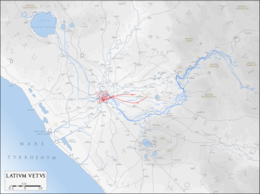
Back Аква Апия Bulgarian Aqua Appia Catalan Aqua Appia Czech Aqua Appia German Υδραγωγείο του Άππιου Greek Aqua Appia Spanish آکوا آپیا Persian Aqueduc de l'Aqua Appia French Acquedotto Appio Italian アッピア水道 Japanese
This article includes a list of general references, but it lacks sufficient corresponding inline citations. (March 2023) |


The Aqua Appia was the first Roman aqueduct[1]: 47 , and its construction was begun in 312 BC by the censor Appius Claudius Caecus[2][3]: 148 [4]: 338-9 [5]: 23 , who also built the important Via Appia. By the end of the 1st century BC it had fallen out of use as an aqueduct, and was used as a sewer instead[6]: 58 [7].
The springs feeding Via Appia were discovered by Appius' co-censor Gaius Plautius Venox, who received the cognomen Venox for the discovery[2][4]: 338-9 [5]: 23 . The aqueduct was named after Appius alone because Plautius resigned after serving 18 months as a cencor[4]: 338-9 while Appius deceitfully kept his position until the aqueduct was completed[4]: 340-1 .
It's not certain how much water Aqua Appia fed to the city of Rome, but in the city records it is mentioned to have 841 quinariae -- 34,901 m3 (9,220,000 US gal) per 24 hours[4]: 388-9 [5]: 25 . However, measurements taken in the 1st century AD resulted with pipes being in total of 1,825 quinariae -- 73,000 m3 (19,000,000 US gal) per 24 hours[4]: 390-1 [1]: 273 . The water was fed to twenty local reservoirs from which it was further distributed to various districts of Rome[5]: 26 [1]: 293 .
In 2016, what is likely to be a 32 m (105 ft) section of the Aqua Appia was excavated 17–18 m (56–59 ft) beneath Piazza Celimontana[6]: 51 [7]. Parts of the excavated section were relocated for reconstruction elsewhere[7].
- ^ a b c Cite error: The named reference
hodge1992was invoked but never defined (see the help page). - ^ a b Cite error: The named reference
romanaqueductswas invoked but never defined (see the help page). - ^ Cite error: The named reference
dogarawas invoked but never defined (see the help page). - ^ a b c d e f Cite error: The named reference
frontinuswas invoked but never defined (see the help page). - ^ a b c d Cite error: The named reference
vandeman1934was invoked but never defined (see the help page). - ^ a b Cite error: The named reference
morretta2020was invoked but never defined (see the help page). - ^ a b c Cite error: The named reference
thelocalwas invoked but never defined (see the help page).